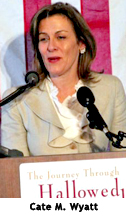|
One tree to be planted for each soldier
who died during Civil War, Wyatt says
“You can’t erase our past,” emphasizes Cate Magennis Wyatt, founder and president of a new Civil War legacy project. “We can’t just take for granted that the stories of those who came before us will be remembered,” she affirms. “And if you lose the beginning of your story, you certainly have a much more difficult time bringing the original ideals of America to fruition.”
 Wyatt heads the “Journey Through Hallowed Ground Partnership,” a non-profit organization to raise awareness of the history and culture of land from Gettysburg, Pa., to Thomas Jefferson’s home in Virginia. Wyatt heads the “Journey Through Hallowed Ground Partnership,” a non-profit organization to raise awareness of the history and culture of land from Gettysburg, Pa., to Thomas Jefferson’s home in Virginia.
“In this 180-mile swath of land, we found that there are nine presidential homes, from Jefferson, Madison, Monroe, straight through Eisenhower. There are sites from the French and Indian War, the Revolutionary War, the War of 1812 and the largest concentration of Civil War battlefields in the country,” she said.
And it’s the Civil War that’s the subject of the Living Legacy Project. The goal is to plant one tree for each of the soldiers – both Union and Confederate – who lost their lives. The first of the trees have been planted at Oatlands, Va., a National Trust site. It’s the geographical center of the Journey Through Hallowed Ground National Scenic Byway. Some 400 trees are being planted or dedicated at Oatlands with many more to come. “A total of 620,000 men died in the Civil War,” Wyatt noted, “many of whom fought on the battlefields within our National Heritage area. So our notion was to plant one tree for each man and march those 620,000 trees up our National Scenic Byway, Route 15, straight on up to Gettysburg. And, as we do so, we allow each visitor to understand that those trees represent a life, a life, a life, as they pass,” she said.
Native trees are being used, including red bud, red maple, red cedar evergreen and red twig dogwood. Each displays its best colors at a different season of the year.
A growing number of historians say the Civil War death toll actually was much higher, perhaps 750,000. They base that on census figures and the fact that many soldiers may have died long after the battles from the wounds they suffered.
Wyatt says, “More than 50 percent who passed were unknown. They died anonymously. And that’s one of the compelling reasons we want to plant a tree for each person to allow it to be a living legacy of that loss.”
She added that “taking for granted” what these men fought and died for would be a “disservice to what it is to be an American.”
“These young men were fathers, sons, husbands, brothers. They had dreams. They were caught in the crossfire of something that was horrible at the time. And what I found over the few years of talking to people is that the Sesquicentennial of the Civil War might mark the 150th anniversary, but there is yet a lot of healing that has to be done. And this one quite humble, but quite intentional project allows everyone to honor the fallen,” she said.
|







